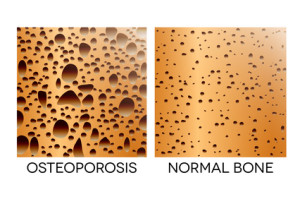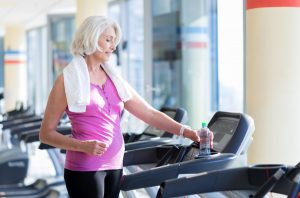For those struggling with chronic medical conditions, exercise can be an often under-utilized way to manage some symptoms and improve others. This is especially the case for diseases like osteoporosis. This is a great opportunity for fitness professionals to utilize their training to really help others.
 Osteoporosis is a disease of the skeletal system in which bones fail to create new tissue and when existing bone tissue breaks down. This means that bone structures on those with osteoporosis are much more susceptible to injury. As such, you — as a fitness professional — are uniquely suited to help osteoporosis patients who need to be much more careful and might require a little bit more creativity in their regimen.
Osteoporosis is a disease of the skeletal system in which bones fail to create new tissue and when existing bone tissue breaks down. This means that bone structures on those with osteoporosis are much more susceptible to injury. As such, you — as a fitness professional — are uniquely suited to help osteoporosis patients who need to be much more careful and might require a little bit more creativity in their regimen.
First of All…
Make sure that the client has cleared their exercise program with their doctor. Nothing can take the place of a qualified medical professional in terms of assessing safety. This also means that you might want to be available to discuss programming with a medical professional if possible. This way, you become an integral part of the individual’s treatment team and can offer valuable insight to both the doctor and the patient as to how they are dealing with one thing or another in relation to their illness.
Structural Considerations
There are quite a few things to take into consideration when programming a client’s regimen. In large part, you can even take an engineer’s approach when thinking about what is most important for them to achieve their goals. For instance, a cable bridge like the Brooklyn bridge in New York City is supported both with pylons and cables. Similarly, the human body has a skeletal and a muscular system which work together to support people.
If the concrete pylons under the bridge started to decay, one could compensate for this a little bit by strengthening the more flexible cables which also work to hold the bridge up. In this same way, if a person’s bones are brittle, their muscles can help compensate for this deficiency to an extent. But that isn’t all.
Bones have also been shown to respond positively to exercise in a similar fashion to muscles. So when you consider the building of muscle as a reaction to contraction and exerted force, bones will react similarly. Just be careful not to do too much.
Injury Prevention is EXTREMELY Important
Whereas most people would agree that injury prevention is important in training, it becomes that much more important to consider when training someone with osteoporosis. When a person with strong bones gets injured, depending on the severity, they might bounce back in a matter of weeks. When someone with osteoporosis gets injured, it can be a matter of months before they can return to training. Psychologically speaking as well, this can lead to a confidence issue which will negatively feed upon itself in the gym.
Staying positive is really critical, both for success in exercise and success in treatment, and injuries which knock you out of commission can completely derail months of work.
Training Approaches
To continue the metaphor about a cable bridge’s support, another way to make those structures more effective is to reduce the amount of weight of the overall structure. Thus, weight loss can be a really helpful goal for the individual. This will alleviate some pressure and will likely lead to less pain.
 Furthermore, strengthening the muscles which surround bones and joints can have a very positive impact on the individual fighting the disease. Stronger muscles mean that, even when sitting or standing, the individual uses less of their bone structure to support their body and uses more of their muscular system. This constitutes great progress.
Furthermore, strengthening the muscles which surround bones and joints can have a very positive impact on the individual fighting the disease. Stronger muscles mean that, even when sitting or standing, the individual uses less of their bone structure to support their body and uses more of their muscular system. This constitutes great progress.
As such, a combination approach is often best. The National Institution of Health notes that load-bearing exercises are best. Although activities like swimming are great for developing muscles and burning fat, there still needs to be a solid land-training component as well. This could be walking, hiking, or — for people who have more advanced experience with exercise — even running.
But cardio alone is insufficient. Resistance exercises will help to build critical muscle mass that will help them to live with less pain and less risk of an accident. This doesn’t mean that they have to start benching 300 pounds. Often times, simple and modified bodyweight exercises are a great way to implementresistance training. For those who are less mobile, resistance bands are incredibly useful.
Circuit Training
Circuit training is a great way to more efficiently train clients. It’s especially the case for those suffering with osteoporosis. As such, you might have a circuit where they perform an individual bodyweight exercise — say modified push-ups, bodyweight squats, and a few balance exercises. Have your clients perform each exercise under your supervision for 30 seconds, then have them walk for 60 seconds, then do the next exercise for 30 seconds, alternating until they get to 20 minutes. Obviously, a program like this can be tweaked to be harder or easier based on the client’s ability level. This is a great way to train outdoors on a track, and is also valuable because it could be used in someone’s living room on days with bad weather as well.
Educate Them for Success
It’s also important to understand that you are not just guiding the individual through their routine, but you are teaching them how to train when you aren’t around. This means that it’s even more important to explain why you are having them do one exercise instead of another and how it fits into the overall picture. Their ability to exercise independently of you will only garner more trust in your client/trainer relationship and they will see gains more quickly. Just remember to keep them safe and teach what you can. They will thank you for the effort!
Jane Curth is the co-founder and CEO of FitFixNow. Helping people on their wellness journey is her passion; Jane has helped clients and students with their diet and fitness struggles for over 20 years.

